A Goblin is a type of fairy originally from European folklore.[1] The word "goblin" is originally derived from the Greek word "Kobalos," which translates into English as "Rogue[2]" or "Evil Spirit.[3]" The word goblin has traditionally been reserved for any ugly fairy that is either mischievous or malevolent.[4] Because of this, the term goblin has been used to describe a wide variety of creatures found in a multitude of traditions throughout Europe. The term goblin can be quite nebulous; and in some cases it can be unclear if a creature would be better described as a goblin, a fairy, or an elf.
After the publication of J. R. R. Tolkien's The Hobbit in 1937 and The Lord of the Rings trilogy between 1954 and 1955, the view of goblins in modern Western fantasy began to change. Goblins were now commonly seen as their own distinct race of humanoid creatures. Typical features of goblins in modern fantasy includes a shorter-than-human stature, either a flat or long and hooked nose, bat-like ears, and either a mischievous or malevolent demeanor.
Somewhat paradoxically, in the study of folklore the term goblin has at times been expanded to include a variety of creatures from non-Western traditions that are seen to be "goblin-like" by Western scholars.
Goblins in Fairy Tales and Folklore
The Benevolent Goblin:
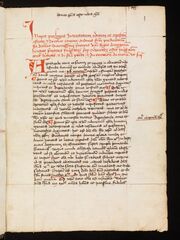
Manuscript page from the Gesta Romanorum from the Médiathèque Valais (Media Library) in Sion, Switzerland.
The Benevolent Goblin is a folk story written by an unknown author that was compiled in the British Gesta Romanorum between the 13th and 14th centuries.[5][6]
Plot:
In a wooded hill in England there once had lived an unusually friendly, helpful goblin. This goblin wore a red robe, and he would help the local knights by offering a mysterious drinking horn that was encrusted with gold and jewels. When the knights drank the unknown liquid from the mysterious horn they would become miraculously cooled and refreshed.
The goblin continued to help the knights, until one day a greedy and deceptive knight ran off with the drinking horn after he asked the goblin if he could drink from it.
The knight was soon captured by the local authorities after he was found bragging about his misdeed, and was imprisoned. The goblin's drinking horn was then given as a gift to the King of England. From that day fourth the goblin was never seen or heard from again.[5][7]
The Goblin Pony:
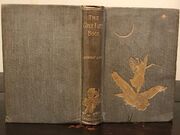
The Grey Fairy Book by Andrew Lang 1900
The Goblin Pony is a traditional French tale that was transcribed and published in 1900 by the Scottish poet Andrew Lang in his collection of short stories, The Grey Fairy Book.
Plot:
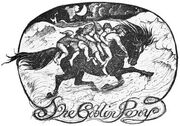
Artwork for the short story The Goblin Pony from The Grey Fairy Book by Andrew Lang (1900)
The short story begins with a grandmother warning her three grandsons not to go out that night because it was Halloween and violently windy. She claimed that this meant that both Witches and their minions, goblins, were out on the prowl. The goblins were said to go out in various disguises in order to harm people.
The three boys ignore their grandmother's plea and go out to pick thyme and blackberries. They then come upon a small, black pony that's said to be "bewitched." This pony is implied by their grandmother's warning earlier in the story and by the title of the story to be a goblin in disguise.
The three boys decided to ride the pony all at once, and they thoroughly enjoyed themselves. They soon found another group of children and invited them to ride with them as well. The pony seemed to be unaffected by the amount of children, so the entire group rode along on it's back. This fun eventually turned into horror when the pony began to run toward the ocean. The children were unable to stop the horse or change its trajectory. The pony ran into the ocean waves while neighing happily as the children drowned. Early in the morning the grandmother decided to look for her grandchildren because the was worried. While looking she encountered the goblin pony, which galloped quickly past her.[8]
This story of children riding a horse to a watery death is very similar to Scottish tales of the Kelpie.
The Goblins Turned to Stone:
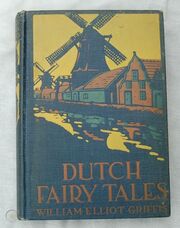
1st edition of Dutch Fairy Tales for Young Folks (1918) by William Elliott Griffis.
The Goblins Turned to Stone is a traditional Dutch short story published in 1918 by the American author William Elliot Griffis in his collection of stories called Dutch Fairy Tales for Young Folks.
Plot:
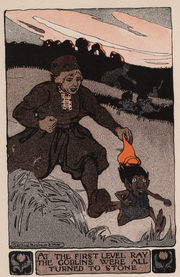
Artwork from Dutch Fairy Tales for Young Folks by William Elliot Griffis depicting a scene from The Goblins Turned to Stone.
The Goblins Turned to Stone begins by explaining the importance of cheese in the traditional dutch diets and it's various uses. It then goes on to explain that the early Dutch were not aware that eating too much cheese caused nightmares, so over time stories of goblins developed in order to explain the nightmares.These goblins are normally invisible to the human eye due to the magical red caps they wear, which make them invisible. During the day they live underground because the sunlight will turn them to stone.
Following this explanation, the story begins with an old woman from the province of Drenthe laying in bed. Just before the old woman falls asleep, she spots a goblin waiting to give her a nightmare at the foot of her bed. She yells to the goblin that she "belongs to the Lord," and called out for daughter Alida. The old woman throw her clogs at the goblin as it tries to escape through a crack in the building. The goblin escapes, but not before Alida manages to grab the red cap from the goblin's head as well as stab the goblin's cloven foot with a needle. The sight of the red cap in her hands gave Alida an idea. This idea could rid the province of the goblins once and for all. Alida left a note for the goblin near the crack where he had escaped. The letter stated that if he ever wanted his cap back, he'd have to bring several hundred of his fellow goblins to the great moor the following night. There they would have a trade. His cap would be found dangling in a bush, but he must leave a gold necklace in the cap's place when he takes it.
The following evening was a moonlit night. Alida gathered all the men in Drenthe and hid in the bushes waiting for the goblins. When the goblin appeared to retrieve his cap the men all ran out grabbing the air at about waist height. One by one the men pulled off the caps of the goblins, turning them visible. The goblins ran every which-way, but the men could tell where a group of goblins was from the one or two who were missing their caps. This continued on the entire night until the sun began to rise. Even though the men only managed to remove the caps from a fraction of the goblins, even the ones who still had their caps were afraid of reporting the event to their goblin ruler. Fearing their ruler's wrath, the decided not to escape when the sun rose, and all the goblins turned to stone.[9]
Goblins in Music and Poetry
Der Erlkönig:
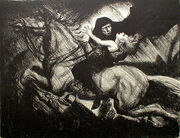
"The Erlking," by Albert Sterner, 1910
Der Erlkönig, which can be translated to English as "The Elf King" or "The Alder King," is a poem written in 1782 by the German writer and poet Johann Wolfgang von Goethe as part of a "Singspiel," a type of Geman light opera, titled "Die Fischerin" or "The Fisherwoman."
The poem was inspired by an ancient Danish ballad called "Elveskud" or "Elf-Shot" in English. The earliest manuscript of this ballad is dated to be from the 1570's, but the story itself is believed to be much more ancient.[10]
Plot:
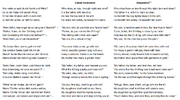
Translation to English of the poem "Der Erlkönig," by Goethe.
The plot of the poem revolves around a young boy is riding at night with his father. While riding to their destination, the Erlking appears to the young boy. Struck with fear, he yells to his father that the Erlking is following them. The father looks, but cannot see any pursuers, and concludes that it must be his son's imagination.
But the son can still see the Erlking, and he is getting closer. The father cannot see the Erlking, even as he reaches close enough to whisper into his son's ear. The boy suddenly screams he's been harmed by the Erlking. When the father reaches his destination, he's shocked to find that his son is dead.
Goblins in Fiction and Literature
The Princess and the Goblin:
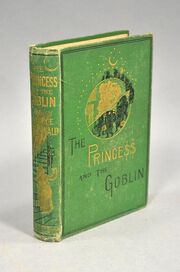
1st Edition of The Princess and the Goblin (1871) by George MacDonald
The Princess and the Goblin is a fairy story written by the Scottish author George MacDonald and published in 1871. It's literary importance comes not from it's plot necessarily, but in it's description of goblins (found in the first chapter of the story). This description would later influence the famous fantasy author J.R.R. Tolkien.
The goblins in The Princess and the Goblin (also referred to as Gnomes or Kobolds) are a small, misshapen, subterranean race with a cruel and mischievous demeanor:
- "The goblins themselves were not so far removed from the human as such a description would imply. And as they grew misshapen in body they had grown in knowledge and cleverness, and now were able to do things no mortal could see the possibility of. But as they grew in cunning, they grew in mischief, and their great delight was in every way they could think of to annoy the people who lived in the open-air storey above them.[11]"
- "They were now, not ordinarily ugly, but either absolutely hideous, or ludicrously grotesque both in face and form. There was no invention, they said, of the most lawless imagination expressed by pen or pencil, that could surpass the extravagance of their appearance. But I suspect those who said so had mistaken some of their animal companions for the goblins themselves—of which more by and by.[11]"
- "They had enough of affection left for each other to preserve them from being absolutely cruel for cruelty's sake to those that came in their way; but still they so heartily cherished the ancestral grudge against those who occupied their former possessions and especially against the descendants of the king who had caused their expulsion, that they sought every opportunity of tormenting them in ways that were as odd as their inventors; and although dwarfed and misshapen, they had strength equal to their cunning.[11]"
Tolkien has openly stated that The Princess and the Goblin was an influence in the creation of his 1937 classic The Hobbit. In one quote Tolkien states that some of the ideas used in the The Hobbit...
- "...derived from (previously digested) epic, mythology, and fairy-story—not, however, Victorian in authorship, as a rule to which George MacDonald is the chief exception...[12][13]”
In another quote, Tolkien states that the goblins found in The Hobbit...
- "...owe, I suppose, a good deal to the goblin tradition...especially how it appears in George MacDonald" and that they" do to some extent resemble...[12]"
Plot:
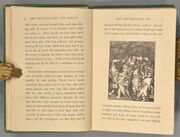
The inside pages of the 1st edition of The Princess and the Goblin showing a depiction of the goblins
The story centers around the young eight year old princess Irene. Princess Irene had lived a very protected life, had never once seen the night sky. He only idea of what the night sky looked like was the paintings on the ceiling of her nursery. She longed to see the night sky, but little did she know, the reason for her protection was that goblins ravaged her kingdom at night.
The young princess, becoming more adventurous with age, begins to explore the tunnels of her castle. To her utter surprise Irene discovers a tower where her magical great, great, great grandmother, also named Irene, resides.
Irene's longing for adventure was not satiated with her previous discovery, and through her persistence, she managed to convince her nursemaid Lootie to take her outside one night. Irene's excitement soon turned to horror when she and Lootie were chased by goblins. Luckily for them, they were rescued by a young miner boy named Curdie.
Curdie was familiar with the subterranean goblins through working in the mines. While working in the mines, Curdie overheard a pair of goblins talking to one another. The goblins were complaining to one another about their one special weakness- their sensitive feet. Curdie also discovered through overhearing the goblins that the goblins had a mysterious plan that, if failed, they would flood the entire mines.
Upon hearing this, Curdie later decides to explore the goblin's underground territory. He attempts to defeat the goblins once and for all by stomping on the goblin's feet one by one. He's almost successful, until he tries to stomp the Goblin Queen's feet. To his dismay, the Queen of the Goblins was wearing shoes made of stone.
Injured, Curdie is imprisoned by goblins. But to his surprise he's soon rescued by Princess Irene. She was able to find him by using a magical thread given to her by her magical great, great, great grandmother. Before escaping to the palace Curdie manages to steal the Goblin Queen's stone shoes while she was asleep.
During Curdie's ordeal with the goblins he discovered that the goblin's were planning to tunnel into the palace in order to kidnap princess Irene so that they could force her to marry Harelip, the prince of the goblins. But instead of being believed, Curdie is imprisoned after attempting to warn the palace guards of the goblin's plans. He's rescued from prison by Irene's magical great, great, great grandmother just as the goblins had burst into the palace through their underground tunnels.
Now possessing the stone shoes, Curdie is able to defeat the goblins by stomping onto their feet. The goblins retreat, but in the commotion it's believed that Irene had been taken. Curdie notices Irene's magical thread and follows it to find Princess Irene alive and well inside his own home. When the goblins attempt to flood the mines the plan backfires and all the goblins drown.[11]
The Hobbit:
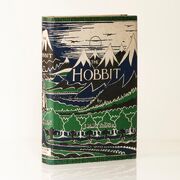
The Hobbit by J.R.R. Tolkien, 2nd Edition from 1959
Tolkien's classic The Hobbit would change the way that goblins were thought about and portrayed in Western Fantasy. In Tolkien's work, goblins were not small fairy creatures, but a monstrous, intrinsically-evil humanoid race of beings. Influenced by The Princess and the Goblin, Tolkien described the goblins as large (at least, large according to a hobbit) and ugly looking:
- "Out jumped the goblins, big goblins, great ugly-looking goblins, lots of goblins, before you could say rocks and blocks.[14]"
When describing the goblins, Tolkien conjures up frog or toad-like imagery. Their voices are described as "stony," their singing is described as "croaks," and their feet are described as "flat" like a frog's webbed feet:
- "The goblins were very rough, and pinched unmercifully, and chuckled and laughed in their horrible stony voices...[14]"
- "The goblins began to sing, or croak, keeping time with the flap of their feet on the stone, and shaking their prisoners as well.[14]"
Tolkien's goblins are a specifically a subterranean race. They are skilled at boring into the earth and possess the ability to see in the dark:
- "It was deep, deep, dark, such as only goblins that have taken to living in the heart of the mountains can see through.[14]"
The goblins are implied to have eaten the ponies that Frodo and his companions were using to traverse through the Misty Mountains:
- "I'm afraid that was the last they ever saw of those excellent little ponies, including a jolly, sturdy little white fellow that Elrond had lent to Gandalf, since his horse was not suitable for mountain-paths. For goblins eat horses and ponies and donkeys (and other much more dreadful things), and they are always hungry.[14]"
The goblins are described as an intrinsically-evil race.They are skilled at creating tools for torture and weapons of war and mass destruction. They also have no qualms about enslaving unwary travelers :
- "Now goblins are cruel, wicked, and bad-hearted. They make no beautiful things, but they make many clever ones. They can tunnel and mine as well as any but the most skilled dwarves, when they take the trouble, though they are usually untidy and dirty. Hammers, axes, swords, daggers, pickaxes, tongs, and also instruments of torture, they make very well, or get other people to make to their design, prisoners and slaves that have to work till they die for want of air and light. It is not unlikely that they invented some of the machines that have since troubled the world, especially the ingenious devices for killing large numbers of people at once, for wheels and engines and explosions always delighted them, and also not working with their hands more than they could help; but in those days and in those wild parts they had not advanced (so it's called) so far. They did not hate dwarves especially, no more than they hated everybody and everything, and particularly the orderly and prosperous...[14]"
- "...and anyway goblins don't care who they catch, as long as it is done smart and secret, and the prisoners are not able to defend themselves.[14]"
In Tolkien's sequel trilogy to The Hobbit, The Lord of the Rings, Tolkien moves away from using the term "goblin," and instead used the term "orc." In the preface to the second edition of The Hobbit (1951) Tolkien writes:
- "Orc is not an English word. It occurs in one or two places [in The Hobbit] but is usually translated goblin (or hobgoblin for the larger kinds).[15]"
Even though in Tolkien's works the terms "goblin" and "orc" are synonymous, within the fantasy genre post-Tolkien goblins and orcs are most often depicted as separate races, with goblins often being smaller and trickier and orcs being larger and more brutish and fearsome.
Goblins in Fantasy Role-Playing Games
Dungeons and Dragons:
Dungeons and Dragons is a tabletop fantasy role-playing game invented by Ernest Gary Gygax and David Arneson in 1974. The role-playing game has had a long list of influences, drawing from both religion, mythology and folklore from around the world, as well as a large slough of literary sources.
One of the notable literary sources that influenced Dungeons and Dragons was J. R. R. Tolkien's The Hobbit and The Lord of the Rings. Many of the races, classes, and monsters found in the game draw directly from Tolkien's work. Tolkien's influence can be seen in the descriptions of goblins found in the various manuals produced over the years as the game has produced new versions. Goblins in Dungeons and Dragons are consistently depicted as being around 4 ft (122 cm) in height.
Dungeons and Dragons Monster Manual (1st Edition) (1974):
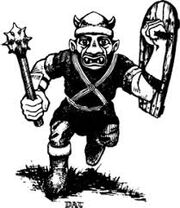
Goblin Artwork from the 1st Edition of the Dungeons and Dragons Monster Manual
- "Goblins have a tribal society, the strongest ruling the rest, allowing fealty to the Goblin King. It is possible the goblins are distantly related to kobolds. Like the latter, goblins enjoy dwelling in dismal surroundings. Although they tend to inhabit caves and similar underground places in preference to any habitation above ground. They too hate full daylight and attack at a -1 when in sunlight. Goblins have normal infravision (60' range)."
- "Goblins are fair miners, and they are able to note new or unusual construction 25% of the time. They hate gnomes and dwarves and will attack them in preference to any other creature. All goblins are slave takers and fond of torture."
- "Description: Goblins range from yellow through dull orange to brick red in skin color. Their eyes are reddish to lemon yellow. They dress in dark leather gear, and their garments tend towards dull, soiled-looking colors (brown, drab, dirty grey, stained maroon). Goblins reach the age of 50 years or so."
Tolkien Lawsuit:
In 1976 The creators of Dungeons and Dragons received a legal challenge concerning the use of terms found in The Hobbit and The Lord of the Rings by the Tolkien estate. The terms in question included "goblin," as well as balrog, dragon, dwarf, elf, ent, hobbit, orc, and warg. Gygax was able to successfully argue that "goblin" as well as the majority of the terms listed were under public domain. After agreeing to change the race "Hobbit" into "Halfling," the creature "Balrog" into "Balor," and the creature "Ent" into "Treant," the case was settled out of court. Gygax states in a post on the website EN World in 2012:
- "TSR was served with papers threatening damages to the tune of half a mil by the Saul Zantes (sp?) division of Elan Merchandising on behalf of the tolkien Estate. The main objection was to the boardgame we were publishing, The Battle of Five Armies. The author of that game had given us a letter from his attorney claiming the work was grandfathered because it was published after the copyrights for JRRT's works had lapsed and before any renewals were made. The action also demanded we remove balrog, dragon, dwarf, elf, ent, goblin, hobbit, orc, and warg from the D&D game. Although only balrog and warg were unique names we agreed to hobbit as well, kept the rest, of course. The boardgame was dumped, and thus the suit was settled out of court at that.[16][17]"
Advanced Dungeons and Dragons Monstous Manual (2nd Edition) (1989):
In the second edition of Dungeons and Dragons more specific descriptions of goblins are given. With these more specific descriptions, the goblins from Dungeons and Dragons begin to become distinct form the goblins of Tolkien. The goblins are given distinctive bat-like features that begin to give the goblins a gremlin-like appearance.
- Description from the 2nd Edition Monster Manual:
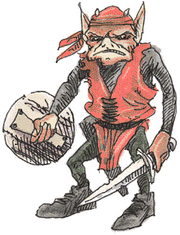
Depiction of a Goblin from the Dungeons and Dragons 2nd Edition Monster Manual
- "These small, evil humanoids would be merely pests, if not for their great numbers. Goblins have flat faces, broad noses, pointed ears, wide mouths and small, sharp fangs. Their foreheads slope back, and their eyes are usually dull and glazed. They always walk upright, but their arms hang down almost to their knees. Their skin colors range from yellow through any shade of orange to a deep red. Usually a single tribe has members all of about the same color skin. Their eyes vary from bright red to a gleaming lemon yellow. They wear clothing of dark leather, tending toward dull soiled-looking colors. Goblin speech is harsh, and pitched higher than that of humans. In addition to their own language, some goblins can speak in the kobold, orc, and hobgoblin tongues."
- "Combat: Goblins hate bright sunlight, and fight with a -1 on their attack rolls when in it. This unusual sensitivity to light, however, serves the goblins well underground, giving them infravision out to 60 feet. They can use any sort of weapon, preferring those that take little training, like spears and maces. They are known to carry short swords as a second weapon. They are usually armored in leather, although the leaders may have chain or even plate mail. Goblin strategies and tactics are simple and crude. They are cowardly and will usually avoid a face-to-face fight. More often than not, they will attempt to arrange an ambush of their foes."
- "Habitat/Society: Humans would consider the caves and underground dwellings of goblins to be dank and dismal. Those few tribes that live above ground are found in ruins, and are only active at night or on very dark, cloudy days. They use no form of sanitation, and their lairs have a foul stench. Goblins seem to be somewhat resistant to the diseases that breed in such filth. They live a communal life, sharing large common areas for eating and sleeping. Only leaders have separate living spaces. All their possessions are carried with them. Property of the tribe is kept with the chief and sub-chiefs. Most of their goods are stolen, although they do manufacture their own garments and leather goods. The concept of privacy is largely foreign to goblins...
- ...In addition to the males, there will be adult females equal to 60% of their number and children equal to the total number of adults in the lair. Neither will fight in battles. A goblin tribe has an exact pecking order; each member knows who is above him and who is below him. They fight amongst themselves constantly to move up this social ladder. They often take slaves for both food and labor. The tribe will have slaves of several races numbering 10-40% of the size of the tribe. Slaves are always kept shackled, and are staked to a common chain when sleeping. Goblins hate most other humanoids, gnomes and dwarves in particular, and work to exterminate them whenever possible."
- "Ecology: Goblins live only 50 years or so. They do not need to eat much, but will kill just for the pleasure of it. They eat any creature from rats and snakes to humans. In lean times they will eat carrion. Goblins usually spoil their habitat, driving game from it and depleting the area of all resources. They are decent miners, able to note new or unusual construction in an underground area 25% of the time, and any habitat will soon be expanded by a maze-like network of tunnels."
Dungeons and Dragons Monster Manual (3rd Edition) (2000):
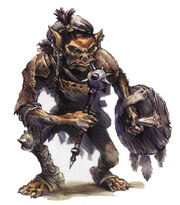
Depiction of a goblin from the Dungeons and Dragons 3rd Edition Monster Manual.
The descriptions of goblins in the 3rd edition of Dungeons and Dragons is strongly based off of the Advanced Dungeons and Dragons (2nd Edition) description, with some paragraphs being almost word-for-word. Even so, there are some added details of note:
- The 3rd edition Monster Manual adds that goblins are "bullied" by larger creatures:
- "Being bullied by larger, stronger, creatures has taught goblins to exploit what few advantages they have: Sheer numbers and malicious ingenuity. The concept of a fair fight is meaningless in their society."
- The manual also goes into more detail about exactly how goblins steal their possessions from others:
- "Goblins survive by raiding and stealing (preferably from those who cannot defend themselves easily), sneaking into lairs, villages, and even towns by night to take what they can. They are not above waylaying travelers on the road or in forests and stripping them of all their possessions, up to and including the clothes on their backs."
- "Goblins often settle near civilized areas to raid for food, livestock, tools, weapons, and supplies."
- Hobgoblins and bugbears are said to travel amongst goblins:
- "Hobgoblins and bugbears are sometimes found in the company of goblin tribes, usually as bullying leaders. Some goblin tribes form alliances with wargs, which carry them into combat."
- Lastly, the goblins are even said to have a pantheon of dieties:
- "The chief goblin deity is Maglubiyet, who urges his worshipers to expand their numbers and overwhelm their competitors."
Dungeons and Dragons Monster Manual (4th Edition) (2007):
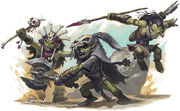
Depiction of goblins from the Dungeons and Dragons 4th Edition Monster Manual
In the 4th edition of Dungeons and Dragons the term goblin has two different meanings. Not only does the term "goblin" stand for a particular race of humanoid creatures, but confusingly, also stands for a broader group of humanoids that includes hobgoblins and bugbears. The 4th edition Monster Manual states:
- "In common parlance, “Goblin” refers to a specific sort of small, ill-tempered humanoid, but the word also refers to related beings of various sizes, such as bugbears and hobgoblins. Goblins are as prolific as humankind, but as a people, they’re less creative and more prone to warlike behavior."
For the description of goblins in the more specific sense, the manual states:
- "Goblins are wicked, treacherous creatures that love plunder and cruelty. They’re not very big or strong, but they’re dangerous when they gang up. Goblins breed quickly and can live most anywhere, from caves to ruins to a city’s sewers. They survive by raiding and robbery, taking every usable item they can carry from their victims.
Dungeons and Dragons Monster Manual (5th Edition) (2013):
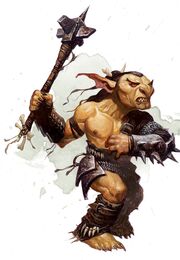
A depiction of a goblin from the Dungeons and Dragons 5th Edition Monster Manual
In the 5th editon there is a clarification in terminology. The term goblin is now only for the specific goblin race, while the term "Goblinoids" is now used to describe the broader category of goblin-like creatures:
- "Goblinoids. Goblins belong to a family of creatures called goblinoids. Their larger cousins, hobgoblins and bugbears, like to bully goblins into submission. Goblins are lazy and undisciplined, making them poor servants, laborers, and guards."
Goblins are said to have little emotional self-control and will uncontrollably celebrate when they defeat their enemies. They also find sadistic joy in torture:
- "Malicious Glee. Motivated by greed and malice, goblins can't help but celebrate the few times they have the upper hand. They dance, caper with sheer joy when victory is theirs. Once their revels have ended, goblins delight in the torment of other creatures and embrace all manner of wickedness."
Goblins are rules by either a "boss" or a goblin king or queen:
- "Leaders and Followers. Goblins are ruled by the strongest or smartest among them. A goblin boss might command a single lair, while a goblin king or queen (who is nothing more than a glorified goblin boss) rules hundreds of goblins, spread out among multiple lairs to ensure the tribe's survival. Goblin bosses are easily ousted, and many goblin tribes are taken over by hobgoblin warlords or bugbear chiefs."
Goblins are known to create booby-traps in their lairs:
- "Challenging Lairs. Goblins festoon their lairs with alarms designed to signal the arrival of intruders. Those lairs are also riddled with narrow tunnels and bolt-holes that human-sized creatures can't navigate, but which goblins can crawl through with ease, allowing them to flee or to circle around and surprise their enemies."
Goblins are said to ride wolves and domesticate rats:
- "Rat Keepers and Wolf Riders. Goblins have an affinity for rats and wolves, raising them to serve as companions and mounts, respectively. Like rats, goblins shun sunlight and sleep underground during the day. Like wolves, they are pack hunters, made bolder by their numbers. When they hunt from the backs of wolves, goblins use hit-and-run attacks."
Lastly, the Monster Manual gives more information on their goblin deity:
- "Worshipers of Maglubiyet. Maglubiyet the Mighty One, the Lord of Depths and Darkness, is the greater god of goblinoids. Envisioned by most goblins as an eleven-foot-tall battle-scarred goblin with black skin and fire erupting from his eyes, he is worshiped not out of adoration but fear. Goblins believe that when they die in battle, their spirits join the ranks of Maglubiyet's army on the plane of Acheron. This is a "privilege" that most goblins dread, fearing the Mighty One's eternal tyranny even more than death."
Goblins in Movies and Television
Labyrinth:
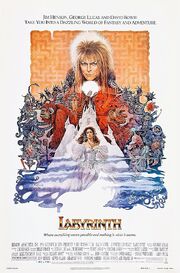
"Labyrinth," directed by Jim Henson, original movie poster (1986)
The 1986 fantasy musical feature-length film, Labyrinth, was directed by the acclaimed puppeteer and creator of "The Muppet's," Jim Henson and executive-produced by the famous director and creator of "Star Wars," George Lucas. The iconic and imaginative creature designs were based off concept art by the renowned fantasy artist Brian Froud, who had worked with Henson on "The Dark Crystal" in 1982. The majority of the characters in the film are puppets created by Jim Henson's Creature Shop. The film originally performed poorly in the box office, making roughly half of it's production costs, and received mixed reviews.[18] Over time however, the film's popularity grew until it became a beloved cult classic.[18]
Plot:
The plot of the story revolves around the 16 year old Sarah, played by Jenifer Connelly. Sarah begins the story as an imaginative young girl who, despite her age, still prefers to play make-believe. One evening, she is tasked with watching her infant brother Toby, played by Brian Froud's son of the same name.[18]
While her parents are away Toby begins to cry and Sarah is unable to console him. In her frustration she wishes for the Goblin King to take him away. Little did Sarah know, Jareth the Goblin King, played by the famous glam rock singer David Bowie, was secretly infatuated with her (something made all the more disturbing by their age difference) and granted her wish. Sarah immediately regrets wishing for her brother to be taken away, and Jareth transports her to The Labyrinth- an enormous maze. Jareth gives Sarah thirteen hours to make her way through the maze to his castle in the center, or else he'll turn Toby into a goblin forever.[18]
In the film Jareth seems to symbolize a controlling and mentally abusive partner. He's obsessed with her, but constantly discourages and underestimates her. When he fears Sarah might actually reach the castle he does everything in his power to sabotage her. Sarah eventually reaches the castle and finally defeats Jareth when she realizes he has no power over her.[18]
Creatures Referred to as Goblins
Below is a list of creatures referred to as goblins in Western folklore and modern fiction:
- The Bauchan (Scottish)
- The Bluecap (English)
- The Boggart (English)
- The Brownie (Scottish)
- The Gremlin (English)
- The Imp (English, French, German)
- The Hobgoblin (English)
- The Kobalos (Greek)
- The Kobold (German)
- The Nisse (Danish)
- The Orc (Tolkien/Warhammer)
- The Redcap (Anglo-Scottish Border)
- The Trow (Orcado-Shethlandic)
Non-Western "Goblins"
In the study of folklore the term goblin has at times been expanded to include a variety of creatures from non-Western traditions that are seen to be "goblin-like" by Western scholars.
America (Central):
- The Chaneque
America (North):
- The Pukwudgie
Arabo-Persia:
- The Ghouls (sometimes compared to or identified as goblins)
- The Jinn (especially Ifrits) are usually translated as goblins.
Japan:
In popular culture
Literature
- Goblins appear in the novel Goblin Secrets.
- Goblins own and operate the only bank in the Wizarding world in the Harry Potter books. The bank, "Gringotts", is named after Gringott the goblin. It is one of the safest places in wizarding Britain, having had only one successful break-in.
Films
- Harry Potter films portray goblins as bankers, as in the books.
Comics
Marvel Comics universe is filled with several characters, mostly villains, donning both names and appearances resembling goblins, included but not limited to the Green Goblin, the Hobgoblin, Menace, the Goblin King and the Goblin Knight. Some of these characters have also been mutated to the point of looking like human-sized goblins, with pointy ears, large noses and scaly-green skin.
Gallery
References
- ↑ https://kids.britannica.com/students/article/goblin/324744
- ↑ https://www.britannica.com/art/goblin
- ↑ The Element Encyclopedia of Magical Creatures: The Ultimate A-Z of Fantastic Beings From Myth and Magic by John and Caitlin Matthews
- ↑ The Element Encyclopedia of Magical Creatures: The Ultimate A-Z of Fantastic Beings From Myth and Magic by John and Caitlin Matthews "In general, the term goblin seems to be used for any of the uglier and more malignant spirits such as Boggarts, Bogies, Bogles and Ghouls."
- ↑ 5.0 5.1 https://www.makefunoflife.net/fairy-tales/the-benevolent-goblin
- ↑ https://www.britannica.com/topic/Gesta-Romanorum
- ↑ https://www.theholidayspot.com/halloween/stories/the_benevolent_goblin.htm
- ↑ https://www.gutenberg.org/files/6746/6746-h/6746-h.htm#link2H_4_0003
- ↑ https://www.gutenberg.org/files/7871/7871-h/7871-h.htm#xvii
- ↑ https://courses.lumenlearning.com/musicapp_historical/chapter/der-erlkonig/
- ↑ 11.0 11.1 11.2 11.3 https://www.gutenberg.org/files/708/708-h/708-h.htm
- ↑ 12.0 12.1 http://www.themiddlepage.net/2013/01/down-down-to-goblin-town-george.html
- ↑ https://www.leavesofgoldpress.com/tolkiens-books/the-princess-and-the-goblin/
- ↑ 14.0 14.1 14.2 14.3 14.4 14.5 14.6 The Hobbit by J. R. R. Tolkien
- ↑ The Hobbit (2nd Edition) by J. R. R. Tolkien (1951)
- ↑ https://web.archive.org/web/20121007050950/http://www.enworld.org/forum/archive-threads/57832-gary-gygax-q-part-iv-4.html#post1026737
- ↑ https://screenrant.com/lord-rings-dungeons-dragons-dnd-race-controversy-lawsuit/
- ↑ 18.0 18.1 18.2 18.3 18.4 https://www.theatlantic.com/entertainment/archive/2016/06/labyrinth-captured-the-dark-heart-of-childhood/489146/
